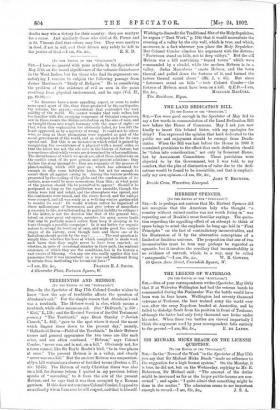TEREBINTHS AND HEBRON.
[TO THE EDITOR OF THE "SPECTATOR."] Sin,—In the Spectator of May 17th Colonel Conder wishes to know "how the age of terebinths affects the question of Abraham's oak." For the simple reason that Abraham's oak was a terebinth. The Hebrew word is sloe, which means a terebinth, while allon means an oak. (See "Delitzsch," p. 350 ; "Kiel," I., 134; and the Revised Version of the Old Testament passim.) "The Terebinth," says Dean Stanley (" Jewish Church," I., 492), "gave to the spot where it stood the name which lingers there down to the present day," namely, " Halkath-el-Butm—Field of the Terebinth." In their Hebrew names and general appearance the two trees are like each other, and are often confused. "Hebron," says Colonel Conder, "never was, and is not, on a hill." Obviously not, for a town cannot, like Sir Boyle Roche's bird, "be in two places at once." The present Hebron is in a valley, and clearly "never was on a hill." But the ancient Hebron was unquestion- ably-a, hill containing a cluster of fortified towns (Joshua x. 37; xiv. 12-15). The Hebron of early Christian times was also on a hill, for Jerome (whom I quoted in my previous letter) speaks of "ascending" to it from the site of the present Hebron, and he says that it was then occupied by a Roman garrison. If this does not convince Colonel Conder, I appeal to an authority whom I am sure he will respect, and that is himself. Wishing to discredit the Traditional Site of the Holy Sepulchre, he argues (" Tent Work," p. 194) that it would necessitate the crossing of a valley by the city wall, which is true, and which, moreover, is a fact wherever you place the Holy Sepulchre. But Colonel Conder clinches his argument with the dictum : "Fortresses stand on hills, not in deep valleys." But the old Hebron was a bill containing fenced towns" which were commanded by a citadel, while the modern Hebron is in a valley. Judas Maccabens "smote Hebron, and the town thereof, and pulled down the fortress of it, and burned the towers thereof round about" (Bk. I, v. 65). But since "fortresses stand on hills "—teste Colonel Conder—the fortress of Hebron must have been on a hill. Q.E.D.—I am,






































 Previous page
Previous page